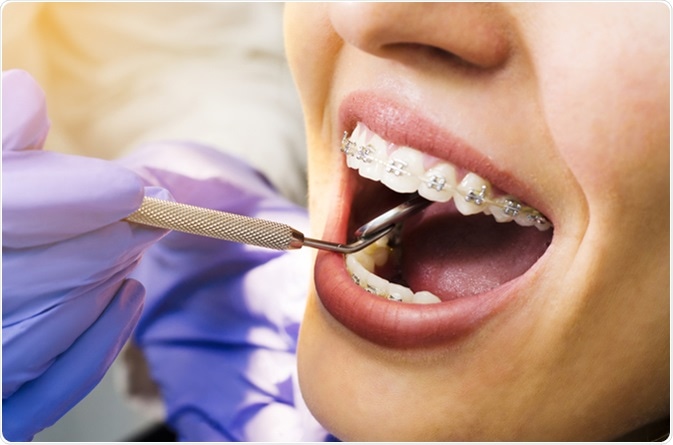Initial Consultation and Examination
The first step for dental braces is for a patient to be referred to an orthodontist due to concerns about the positioning of the teeth in the jaw. In the first orthodontist appointment, the teeth should be examined manually and with X-rays images. It is also important to discuss the dental history with the patient, which will help to guide the treatment decisions.
If from the initial consultation it is deemed that treatment with dental braces is appropriate for the patient’s situation, further decisions such as the type of braces and the duration of treatment will need to be decided.

Closeup of young woman with braces dental checkup. Image Credit: Phoenixns / Shutterstock
Fitting of Dental Braces
A cheek retractor is used to make sure that the teeth remain dry and visible throughout the procedure to place dental braces. The teeth should be polished well, conditioned, air-dried and primed before the brackets are placed to help the bonds to form properly.
Dental cement is used to hold the brackets in place on the teeth, in the exact position that was determined during the initial examinations. Any excess dental cement can then be removed, and the bonding of the brackets to the teeth is strengthened with a high-intensity light.
Once the dental braces are in place as desired, the cheek retractor can be removed and dental arch wires can be put in place. The complete placement process is relatively fast and typically takes less than 20 minutes.
How To Put Braces ON (2015)
Adjustment of Dental Braces
Regular appointments to adjust the dental wires are needed to ensure that the repositioning of the teeth continues throughout the process. These appointments are necessary because elastic ties that hold the wires in place stretch and become weaker with time so that the pressure is reduced.
During each adjustment appointment, the movement of teeth and progress so far with the dental braces should be evaluated, which helps to make ongoing decisions. The elastic ties that hold the braces in place and arch wires are removed, and new ties and wires are then placed.
Most patients will feel some tightness or soreness in their mouth shortly after each orthodontist appointment, which typically presents four to six hours after the appointment and may last for several days. This occurs due to the change in position of the teeth as they react to the pressure created by the dental wire on the braces. Simple analgesic medications such as paracetamol or ibuprofen may be beneficial for pain relief; this is particularly true as eating can be painful during this time.
There should be a period of at least three weeks between each adjustment appointment to allow time for the teeth to move. The frequency of appointments will depend on the intended movement of the teeth and the type of dental wire that is being used.
Removal of Dental Braces
At the conclusion of treatment with dental braces when the teeth have been repositioned as desired, it is time to remove the braces. This process is relatively simple and not painful.
Firstly, the ties and wires should be removed, the same process that occurs during each adjustment appointment. Then the bond between the brackets and the teeth formed with dental cement should be gently broken by applying pressure to the base of the brackets to squeeze them, which releases the adhesive bonds. The adhesive dental remains on the teeth so that the teeth and enamel are not damaged in the removal process. The remaining cement can consequently be removed with a dental hand piece, similar to that used for the repair of a dental cavity.
Many patients notice some inflammation of the gums following the procedure to remove dental braces, but this typically subsides within a few days with adequate oral care.
Follow up appointments with the orthodontist are necessary to have a retainer made, which helps to support the new position of the teeth and improve the retention period of the treatment.
References
Further Reading